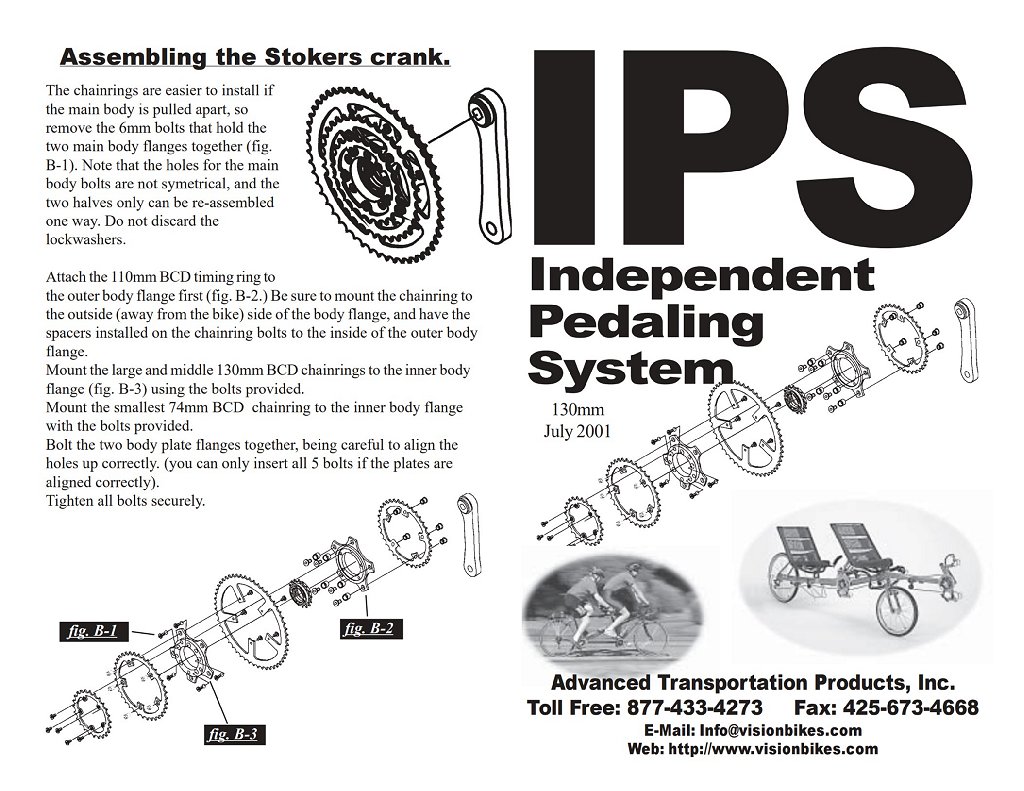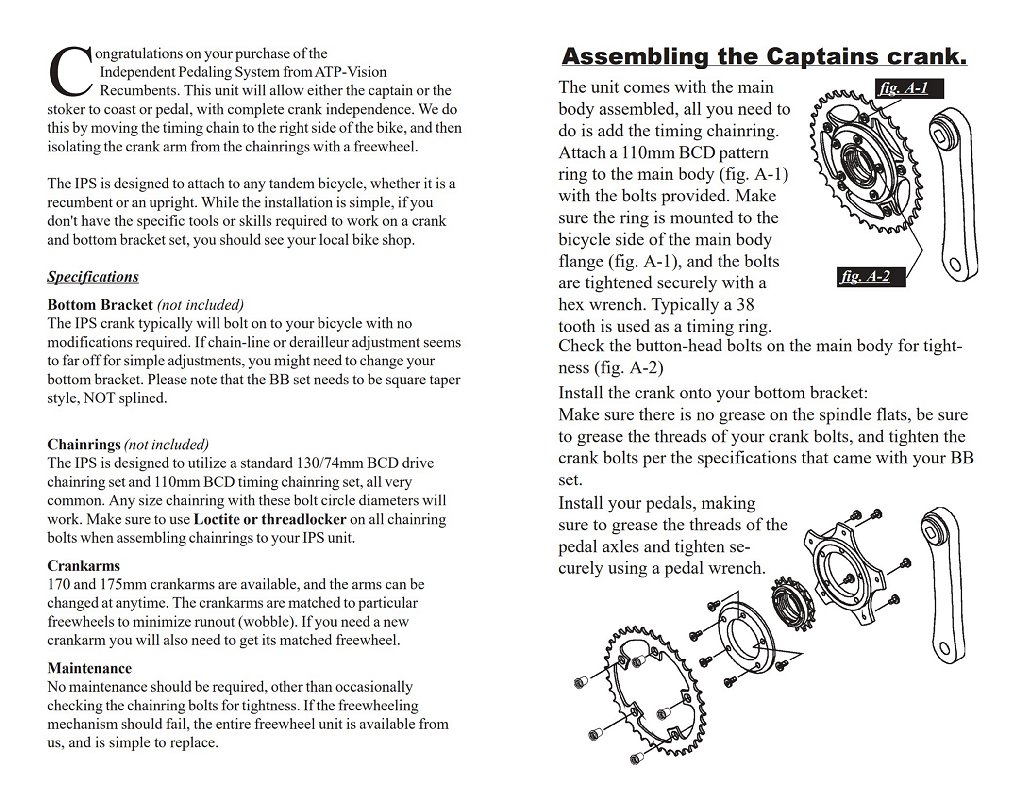|
BIKES: R20
R30
R32
R40
R42
R44
R45
R50
R54
R55
R64
R65
R68
R70
R72
R82
R85
Patents Assigned to Advanced Transportation Products, Inc. Independent pedaling system for tandem bicycles Patent number: 5964472 Abstract: A drive system for a tandem bicycle (10) to allow a captain or a stoker to pedal independently of one another. When the freewheel assembly is incorporated in both the captain crank assembly and the stoker crank assembly, either rider may stop pedaling while the other rider continues to pedal forward. Type: Grant Filed: February 14, 1997 Date of Patent: October 12, 1999 Assignee: Advanced Transportation Products, Inc. Inventors: Joel N. Smith, Grant Bower, Terry McIlraith   See also the Independent pedaling system PDF document.
Independent pedaling system for tandem bicycles
FIELD OF THE INVENTION The present invention relates generally to systems for generating motion of a tandem bicycle and, more particularly, to a pedaling system for a tandem bicycle. BACKGROUND OF THE INVENTION Conventional tandem bicycles include drive systems that provide a direct linkage between the pedals of the front rider, or captain, and the rear rider, or stoker. The direct linkage results in a pedaling system in which both the captain and stoker must start and stop pedaling at the same time, and generally pedal at the same cadence. The captain and stoker must also start at the same place of a stroke. A directly linked pedaling system can be quite difficult to master for an inexperienced cycling pair or a cycling pair with different physical capabilities. The cycling pair must be able to effectively communicate to execute pedaling functions, such as coming to a stop or adjusting toe straps. Moreover, the cycling pair must always maintain the same cadence while pedaling. Because the pedals are linked, one rider cannot rest while the other rider maintains the speed of the bike. As a result, a captain and stoker having different levels of fitness often find that they are unable to ride at a rate where both riders are comfortable. Bicycle manufacturers have recognized that it would be advantageous to allow a rider on a tandem bicycle to pedal independently of a partner, and have attempted to design drive systems that would accomplish such a goal. The present invention is directed to providing a system that allows independent pedaling by the captain and stoker on a tandem bicycle. SUMMARY OF THE INVENTION In accordance with this invention, a drive system that allows independent pedaling of a tandem bicycle is provided (hereinafter the "independent pedaling system"). The tandem bicycle includes a first and second pedaling station in which are seated a captain and a stoker. The independent pedaling system allows independent pedaling by the captain, the stoker, or both the captain and the stoker. In the latter system, the stoker may stop pedaling while the captain continues pedaling in a forward direction, or the captain may stop pedaling while the stoker continues pedaling in a forward direction. As in conventional systems, the stoker and captain may also simultaneously stop pedaling. The independent pedaling system may be incorporated in a captain crank assembly, a stoker crank assembly, or both assemblies. A crank assembly that allows independent pedaling is constructed around a unidirectional bearing, e.g., a freewheel assembly. The freewheel assembly is secured between a first adapter plate and a second adapter plate. Chainrings are coupled to the first and second adapter plates. A crank arm is attached to the freewheel assembly, and the freewheel assembly fixed to an axle of a conventional bottom bracket on the tandem bicycle. A second crank arm is attached to the axle on the opposite side of the bottom bracket. The freewheel assembly allows pedaling in only one direction. That is, pedaling or turning the crank arms in one rotary direction causes the freewheel assembly to engage and turn an attached chainring. Pedaling or turning the crank arms in the opposite rotary direction does not engage the freewheel assembly and turn the chainring. If the chainring is maintaining a constant rotary velocity, the crank arms must be turned at a rotary velocity equal to the constant rotary velocity of the chainring in order for the freewheel assembly to engage and provide power to the chainring. In accordance with one aspect of the invention, the captain crank assembly is linked to the stoker crank assembly by a single chain. The stoker crank assembly is linked to the rear hub of the bicycle by a second chain. Only two chains are therefore required to implement a system allowing the captain and stoker to pedal independently on a tandem bicycle. The two chains are preferably located on the same side of the tandem bicycle frame, further simplifying the construction of the system. In accordance with yet another aspect of the invention, the independent pedaling system may be easily retrofitted onto existing tandem bicycles to allow a stoker and a captain to pedal independently. The independent pedaling system simply replaces the existing chainring and crank arm assembly on the bike. The independent pedaling system may therefore be used with an existing and conventional derailleur system. The independent pedaling system also does not require any structural changes to the frame of a conventional tandem bicycle. In accordance with still another aspect of the invention, the number and type of chainrings that may be fixed to the first and second adapter plates may be varied. By varying the size of the chainrings in the system, the captain and the stoker may select a desired gearing that allows the captain and stoker to pedal at different cadences. As will be readily appreciated from the foregoing summary, the independent pedaling system provides several advantages over the jack-shaft system disclosed in the prior art. Because the independent pedaling system of the present invention does not require an extra shaft and chain, the system is lighter, costs less, and is generally less complex to maintain and repair. Moreover, because the system does not require a third axle, the system may be easily retrofitted into conventional tandem bicycles. The disclosed independent pedaling system therefore improves the overall experience of riding a tandem bicycle. |
